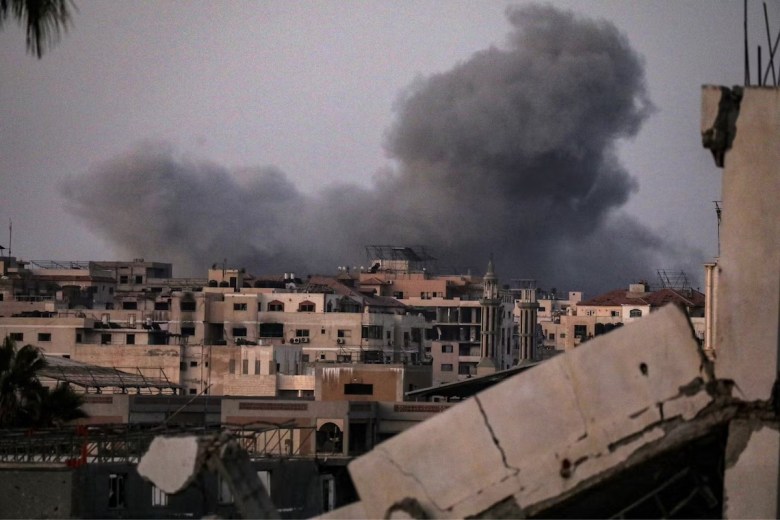Politics
Trump’s Gaza Plan Offers Hope Amid Challenges for Hamas

A new 20-point peace plan aimed at resolving the long-standing conflict in Gaza has been proposed under the leadership of the United States and has received agreement from Israel. This plan represents one of the most comprehensive efforts by the Trump administration to establish a framework for peace with Hamas. Notably, it has reportedly garnered support from various Arab states as well as the United Kingdom and France.
Despite its potential significance, Hamas has not participated in the plan’s development and has yet to respond formally, although it is said to be reviewing the details. Prime Minister Benjamin Netanyahu has raised concerns about the plan’s viability by stating that Israel will “forcibly resist” the establishment of a Palestinian state, a statement that appears to contradict his endorsement of the proposed framework.
Key Elements of the Proposal
The peace plan includes several provisions that could be appealing to Hamas. It outlines a ceasefire to end hostilities immediately and proposes the release of nearly 2,000 Palestinian prisoners, including approximately 1,700 from Gaza. Additionally, Hamas members who choose to disarm and accept coexistence with Israel will be granted amnesty and the option to relocate if they desire. Importantly, the plan states that Israel will not annex or occupy Gaza, but it does call for a security perimeter around the region, which may still be perceived by many Palestinians as a form of occupation.
Humanitarian aid is also addressed in the proposal, with the restoration of aid to civilians in Gaza based on terms established during the January 2025 ceasefire. The plan acknowledges the essential role of the United Nations and the Red Crescent in distributing this aid, which is seen as a crucial concession. Moreover, it emphasizes that no one will be compelled to leave Gaza, encouraging individuals to remain while allowing those who wish to leave the freedom to return.
Hamas’s Concerns and Future Implications
Despite some appealing aspects, Hamas is likely to identify several red flags within the plan. Reports earlier this year indicated that some Hamas leaders were open to a phased disarmament process. However, full disarmament may prove challenging, particularly if significant areas of Gaza remain under Israeli control and the timeline for Israeli troop withdrawal is unclear. Hamas is expected to seek explicit guarantees regarding the withdrawal of Israeli forces before considering any commitment to disarmament publicly.
The proposal also lacks clarity regarding how to prevent renewed hostilities after hostages are released. According to the plan, hostilities would cease immediately upon signing, followed by a 72-hour period for all hostages to be freed. Hamas will likely require assurances from the United States and regional allies that conflict will not resume once hostages are back in Israeli hands, a critical issue that has previously hindered negotiations.
Furthermore, the plan envisions a two-tiered governance model in Gaza, with a technocratic Palestinian committee managing day-to-day operations, while an international transitional body, led by Donald Trump and including figures like former UK Prime Minister Tony Blair, oversees the process. Blair’s involvement may be contentious, given his previous role in the Iraq War and criticism of his tenure in the Quartet mediating the Israel-Palestine peace process.
There is also ambiguity regarding the future role of the Palestinian Authority. The plan states that any governance involvement by the PA would be contingent upon reforms outlined in Trump’s earlier proposals, but it remains unclear who would evaluate these reforms. Netanyahu has explicitly rejected a role for the PA in Gaza governance.
Ultimately, the proposal acknowledges Palestinian aspirations for self-determination and statehood but avoids committing to a clear framework for implementing these objectives. Netanyahu has made it clear that he will oppose any moves toward Palestinian statehood, leaving significant questions unanswered about the future of the region.
As the conflict continues to devastate Gaza, many residents are desperate for an end to the violence. Hamas, recognizing that Trump’s plan may be the most favorable offer it will receive from the US and Israel, faces a critical decision on whether to navigate the plan’s complexities or frame any objections as a reason to continue hostilities.
Julie M. Norman is a senior associate fellow on the Middle East at RUSI and an associate professor in politics and international relations at University College London. This article is republished from The Conversation under a Creative Commons license.
-

 Business5 months ago
Business5 months agoKenvue Dismisses CEO Thibaut Mongon as Strategic Review Advances
-

 Lifestyle4 months ago
Lifestyle4 months agoHumanism Camp Engages 250 Youths in Summer Fest 2025
-

 Sports4 months ago
Sports4 months agoDe Minaur Triumphs at Washington Open After Thrilling Comeback
-

 Sports5 months ago
Sports5 months agoTupou and Daugunu Join First Nations Squad for Lions Clash
-

 Top Stories5 months ago
Top Stories5 months agoColombian Senator Miguel Uribe Shows Signs of Recovery After Attack
-

 World5 months ago
World5 months agoASEAN Gears Up for Historic Joint Meeting of Foreign and Economic Ministers
-

 Health4 months ago
Health4 months agoNew Study Challenges Assumptions About Aging and Inflammation
-

 Business5 months ago
Business5 months agoOil Prices Surge Following New EU Sanctions on Russia
-

 Entertainment4 months ago
Entertainment4 months agoDetaşe-Sabah Violin Ensemble Captivates at Gabala Music Festival
-

 Entertainment4 months ago
Entertainment4 months agoBaku Metro Extends Hours for Justin Timberlake Concert
-

 Top Stories5 months ago
Top Stories5 months agoRethinking Singapore’s F&B Regulations Amid Business Closures
-

 Business5 months ago
Business5 months agoU.S. House Approves Stablecoin Bill, Sends to Trump for Signature









